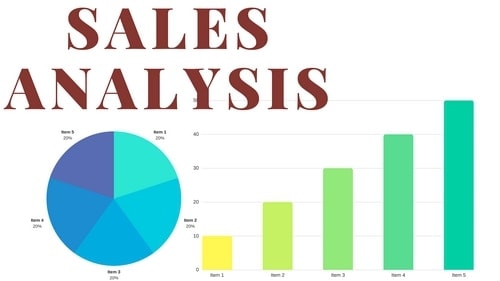For every company, Sales is the ultimate revenue generator which takes care of all costs and expenses. While Sales may be achieved easily or in some cases in a very difficult way, analysis of the Sale that has materialized is very important.
Not only the how but also the why a particular sale has happened and why not has a sale not happened along with a periodic comparison of achieved Sales is very important for the organization. This helps them to give a logical answer of Sales instead of relying on gut-feeling. That is why Sales analysis is carried out from time to time. If you have heard about Sales reviews, then it is nothing but sales analysis carried out as a timely activity.
Table of Contents
What is Sales analysis?
As the name suggests, sales analysis involves analysing the sales made by a company over a period of time. Many companies have a weekly sales analysis, a monthly sales analysis or a quarterly sales analysis. A regular sales analysis helps the company understand where they are performing better and where they need to improve.
Every company has a sales target which its salesmen have to achieve. If the target was to be achieved in a month, then on the 15th day of that month, the salesmen should know where they stand. This is where sales analysis plays it role. It helps determine where the company stands in terms of sales and then helps in sales strategy to reach a predetermined goal.
Sales analysis is done from the bottom level to the top level of the company. Even the CEO of the company does a sales analysis to understand segments where the company is gaining in sales and segments where it is dropping in sales. Such sales analysis can also help product development.
Importance of Sales Analysis
1) Missed opportunities :
Analyzing the available data can show the company where it has missed the opportunity and if or not that can be claimed. Market research will play an important role in this presenting data to compare while the field force will prove of valuable assistance in informing the practicalities of the situation.
2) Future decisions :
Sales data will help a company to take a future decision in terms of inventory management, marketing activities, schemes or offers to be rolled and changes in manufacturing processes if applicable. Based on Sales data, major decisions like continuing or discontinuing a product is taken. Those future decisions will help the external stakeholders of the company to decide whether or not to invest in the company.
3) Market Trends :
Sales analysis will also show the current market trends to the company. While the company may be preparing to launch a new product, Sales Analysis would show a drastic increase in Sales of the earlier product after an activity, showing that it was the lack of awareness which was a hindrance in realizing Sales and not the product. Also, Sales of a certain product may skyrocket during a festival or decrease seasonally.
4) Customer analysis :
Effectively, Sales Analysis is nothing but Customer Analysis. Answering why did a particular customer buy the product in a particular month may give crucial customer insights which will help with the planning of the company.
5) Detailed analysis :
A detailed Sales Analysis is broken down product wise, customer wise, year and month wise and geography wise is a source of huge information for the company.
Types of Sales Analysis:
Although many companies may use various types tailored to fit their organization, here are the few common types of Sales Analysis performed :
1) Periodic Analysis :
This can be a month on month or year on year or year till date compared to previous year till date as the need may be. This gives insight into the impact of time on sales.
2) Product wise Analysis :
Sales of products during different times in different areas can be used. This is majorly used in large-scale equipment.
3) Channel of distribution wise :
This will give the trend of where the sales are maximum and answering Why will give more insights and help the company decide whether or not to continue with the current channel of distribution.
4) Forecast vs Achievement analysis :
This gives the details of sales which were used to forecast the numbers – and inventory was arranged accordingly – and what is the actual achievement of Sales – and whether the inventory needs to refilled or schemes need to be rolled out for the liquidation of stocks.
5) Combination of above :
For more detailed analysis, the company may perform a combined analysis of above for example multinationals like Proctor and Gamble may analyze the Sales of Tide detergent in Asia Pacific region for the year 2018 and compare it with Sales of the year 2017. This involves Product as well as periodic sales.
Advantages of Sales Analysis :
1) Opportunities :
Sales analysis of own products as well as competitor products is important as analyzing sales of competitors allows insights into the market from a different perspective and may help the company to reach the missed out customers and grab the missed opportunity.
2) Decision driver :
Sales analysis, as explained above acts a decision driver for the company to make major changes in their products. If the Sales of a product are not up to the mark, the company may discontinue the product with immediate effect. For example, as the Sales of Touchscreen phones increased all the traditional button models changed their phones to touch screens. With the advent of Facebook and Twitter, earlier sites like Orkut had to be shut down because of lack of revenue and shift of audience from one platform to other.
3) Customer Service :
Knowing the reason behind why a particular sales occurred during particular time will help the companies to keep the inventory ready and help them to serve the customers better. Delighting the customers will, in turn, benefit the company by increased sales further and help to develop goodwill and establish the brand value of the company.
4) Marketing support :
Sales of a certain product may require one-time marketing support or multiple times or seasonal support. Those decisions are taken based on Sales analysis. For example, products like cough syrup would require marketing and ad campaigns just before and during winter while airline services require constant marketing support.
Disadvantages of Sales Analysis :
1) Reliability :
A lot of times, Sales Analysis might have done in a haphazard way or the reasons for the increase in sales of a particular product may go up purely on the effort of the Salespersons or offers rolled out. This may have nothing to do with customer or trends and relying on those conclusions can be problematic for the company.
2) Political factors :
12 countries in Europe introduced a single currency in 2002 which caused temporary disruption of the economy. In such cases, even though the trend may say that the Sales is supposed to increase, owing to unavailability of purchasing power of customers, the company may face a dip in sales. The following year to this incident when the economy may again stabilize, comparing previous years’ data will show askew results again since the customers are purchasing normally as per their requirement but there would be a tremendous growth in the analysis.
3) Technical knowledge :
High technical knowledge is required for Sales Analysis and not everyone may be suited to do that. Good arithmetic skills along with high market knowledge are basic requirements and those may not be fulfilled by every Salesperson.
4) Cost :
A detailed Sales Analysis along with its interpretation is outsourced by many companies. The dedicated firms or software may be costly which the company would have to bear regularly. Also, the privacy of data would be compromised when sharing the Sales data to the third party. A Sales analysis performed by an internal employee instead of outsourcing would increase the cost of the firm in terms of salary, training the person for technical knowledge and there are chances of human error in Manual Sales Analysis.
Liked this post? Check out the complete series on Sales

